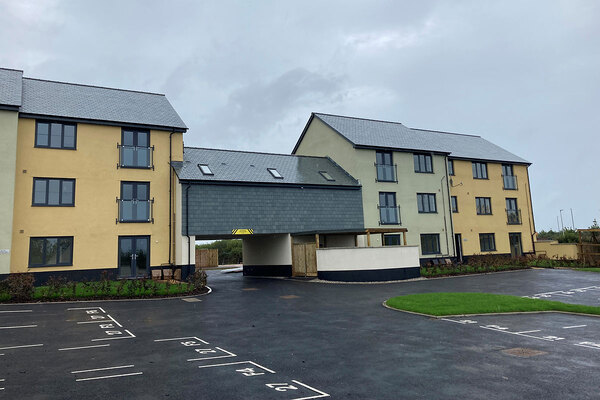You are viewing 1 of your 1 free articles
 Jules Birch
Jules BirchMore is less
 Jules Birch
Jules BirchThere are at least three contrasting and sometimes conflicting imperatives at the heart of the prospectus for the Affordable Homes Programme published this week.
The first (let’s call it the HCA one) is a pragmatic desire to do more with less in difficult circumstances. The second (the political one) is the imperative of big numbers to be able to quote in press releases and in parliament. The third (the ideological one) is a determination to exploit these circumstances to accelerate the slow death of social housing. Amid the tensions between these three aims several vital issues are barely addressed or else ducked completely.
A quick read of the introduction by housing minister Kris Hopkins illustrates all of these points and more. He boasts that £3.3 billion plus £20 billion in private investment will ‘support the delivery of 165,000 additional affordable homes’. That’s on top of ‘the already strong track record of this Government, with over 170,000 affordable homes built over the last three years’. Leaving aside the fact that there will – probably – be 170,000 but they won’t be finished till 2015, these are nice big numbers to deploy at every opportunity along with the one about the biggest housing programme for 20 years.
But his next statement really made me think:
‘Every penny of public money must be spent wisely, to deliver the most benefit for our citizens. That is why we overhauled the model for funding affordable housing in the current programme. As a result, we now get more than twice as many homes from each pound of public money we spend on grant, compared to the 2008-2011 programme.’
The last bit may be true but is ‘every penny of public money’ really being spent wisely when everyone knows that there is a long-term price to be paid for Affordable Rent that will get higher the more it is used? Money saved on grant now by the DCLG will have to be paid out by the DWP in future to cover the housing benefit bill on the higher rents.
It was far from clear even in the DCLG’s own impact assessment of Affordable Rent 1 that it offered the best value for money over the long term. Questions were also raised by both the National Audit Office and the Public Accounts Committee about the 2011-15 programme, even though less than half of it consists of Affordable Rent homes and only a limited number of conversions of re-lets were envisaged. They have still not been answered before the 2015-18 programme of 165,000 homes mostly for Affordable Rent plus accelerated conversions and disposals. The detail has no doubt been discussed with the DWP but, given that the programme only starts after the next election and the bill will only be paid over the long term, you wonder how hard the point was pressed.
‘Value for money’ is mentioned 44 times in the document but not defined anywhere. ‘Housing benefit’ gets only five mentions and three of those are in an annexed letter from 2011. The only consideration that I can find of the long-term costs and benefits comes in a paragraph on ‘meeting local needs’. Local authorities will be able to give their views on the programme but:
‘For the purposes of this programme, it is not expected that local authority priorities will include a preference for social rent over Affordable Rent the intention of the programme is to provide new Affordable Rent homes (and, where appropriate, affordable home ownership homes). In general, Government policy does not support the argument that only rents at or close to social rent levels are capable of meeting local needs, particularly when support for housing costs through Housing Benefit and Universal Credit is taken into account.’
Housing benefit will, in other words, continue to ‘take the strain’ even though, as DWP ministers never cease to remind us, it is also ‘out of control’.
Then there is the whole issue of what counts as ‘affordable’. The word is mentioned more than 200 times but is not defined anywhere except by the assumption that anything that is up to 80 per cent of market levels must therefore be ‘affordable’. But affordable for who? For the DCLG in terms of minimising the capital grant required up front for the maximum number of homes? Tick. For the tenants? Nobody seems very interested. For the DWP’s housing benefit budget? Who cares?
Affordable Rent 2 is quantifiably different to what went before. What in 2010 was a short-term fix has become a wholesale shift from social to ‘affordable’ without any public debate about the rents that tenants can actually afford. The requirement on conversions of re-lets seems to have been fairly easy to ignore in the first round but social landlords wanting grant funding in the 2015-18 programme will have to demonstrate ‘value for money’ not just in their bids to build new homes but also in their conversion of re-lets to Affordable Rent and their plans to sell off high-value stock.
The Greater London Authority’s version of the programme published before Christmas recognised some of these tensions by allowing for some ‘capped rent’ homes in areas where Affordable Rent would be too expensive. The HCA prospectus covers the rest of the country and does not have to deal with the same extremes as in the capital but it offers little alternative to Affordable Rent or affordable home ownership. There are additional measures to prevent local authorities from blocking Affordable Rent in their areas. Even on the smaller homes intended for bedroom tax downsizers ‘providers, supported by the relevant local authorities, will have to make a strong case to demonstrate why Affordable Rent would not be a viable alternative’, leaving open the possibility that a new smaller home could actually be more expensive. And localities where there is little difference between social rents and 80 per cent of market rents will not escape either: they will be expected to convert re-lets to shared ownership.
In an excellent blog this week Colin Wiles urges housing providers to ‘just say no’ to the new regime and refuse to bid. I hope many of them will do just that: in some ways, the prospectus points in this direction by saying that it expects a proportion of the homes to be delivered without grant. That being the case, why not act independently without the strings?
However, recent history shows that each time housing associations have been presented with a chance to say ‘no’ to new conditions for grant funding enough have said ‘yes please, where do we sign?’ to allow it to go ahead. That was what happened with the introduction of private finance in the first place, with each successive reduction in the grant rate and with the first round of affordable rent, which ended up being over-subscribed despite quite widespread doubts expressed in advance by anonymous chief executives.
Which brings me back to those three contrasting and conflicting aims. From a pragmatic point of view, the best associations have become more business-like and efficient, delivering more for less, so why not make the rest of the sector follow suit? Why shouldn’t organisations that receive public money have a duty to manage their assets as efficiently as possible? Shorn of the newspeak title of ‘Affordable Rent’, there is a pragmatic case to be made for delivering new homes at higher rents to maximise output. This seems to a trend across the developed world and SNP Scotland and Labour Wales both have schemes that include homes at closer to market rents.
But these are additions to, not replacements for, a social housing programme and they do not involve converting or selling off what already exists. In England politics and ideology have trumped pragmatism and policy in the rush to implement Affordable Rent for new homes and for whole swathes of the existing stock. Using the assets created in the past to invest wisely for the future is one thing. Cashing in the ‘value for money’ generated in the past to create a future that will not be ‘affordable’ is quite another. When it comes to Affordable Rent 2, more is less.







